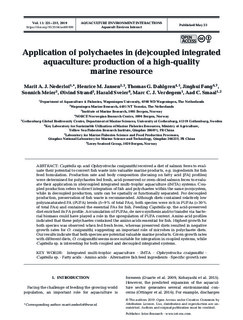| dc.description.abstract | Capitella sp. and Ophryotrocha craigsmithi received a diet of salmon feces to evaluate their potential to convert fish waste into valuable marine products, e.g. ingredients for fish feed formulation. Production rate and body composition (focusing on fatty acid [FA] profiles) were determined for polychaetes fed fresh, acid-preserved or oven-dried salmon feces to evaluate their application in (de)coupled integrated multi-trophic aquaculture (IMTA) systems. Coupled production refers to direct integration of fish and polychaetes within the same (eco)system, while in decoupled production, units can be spatially or functionally separated. For decoupled production, preservation of fish waste is recommended. Although diets contained relatively low polyunsaturated FA (PUFA) levels (5-9% of total FAs), both species were rich in PUFAs (>30% of total FAs) and contained the essential FAs for fish. Feeding Capitella sp. the acid-preserved diet enriched its FA profile. Accumulation of PUFAs, de novo synthesis and/or transfer via bacterial biomass could have played a role in the upregulation of PUFA content. Amino acid profiles indicated that these polychaetes contained the amino acids essential for fish. Highest growth for both species was observed when fed fresh feces, whereas preserved diets resulted in negative growth rates for O. craigsmithi, suggesting an important role of microbes in polychaete diets. Our results indicate that both species are potential valuable marine products. Given growth rates with different diets, O. craigsmithi seems more suitable for integration in coupled systems, while Capitella sp. is interesting for both coupled and decoupled integrated systems. | nb_NO |
